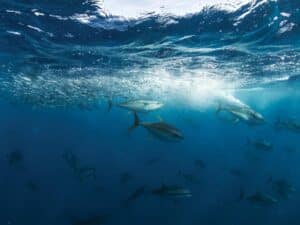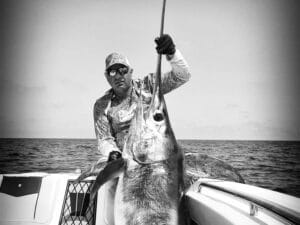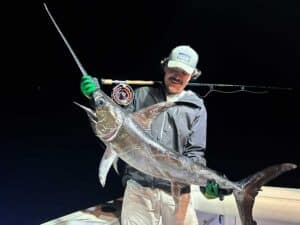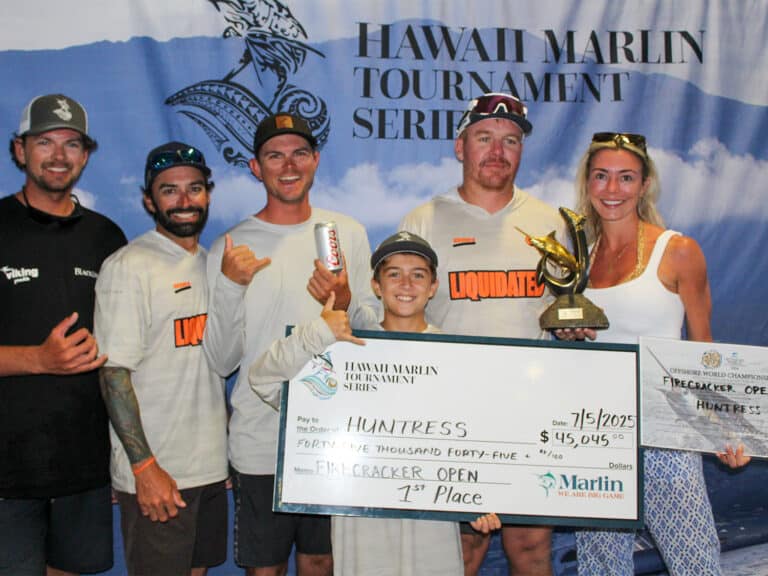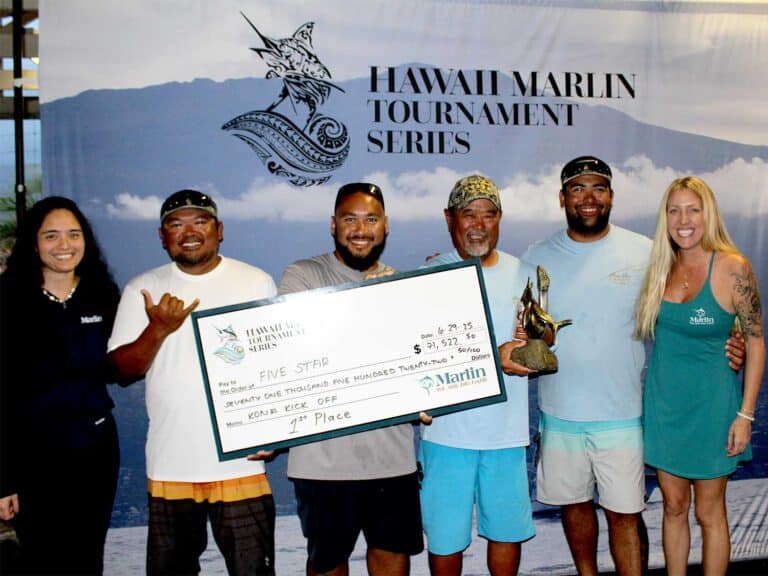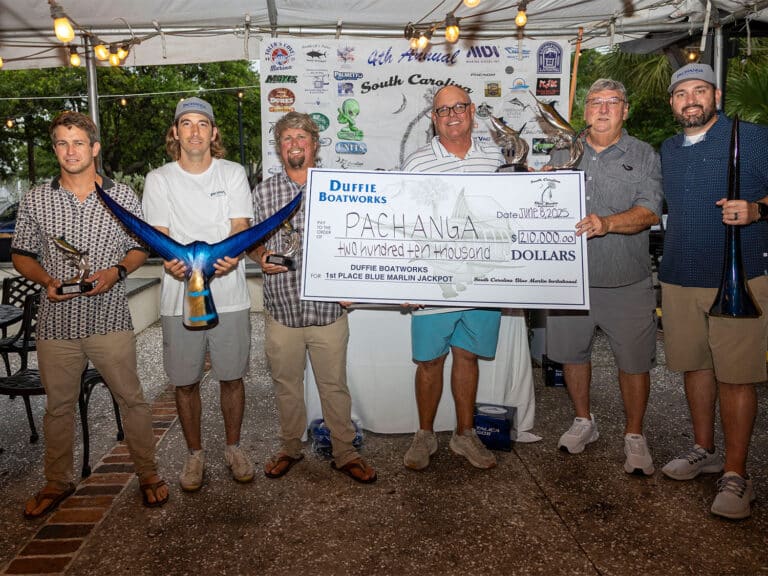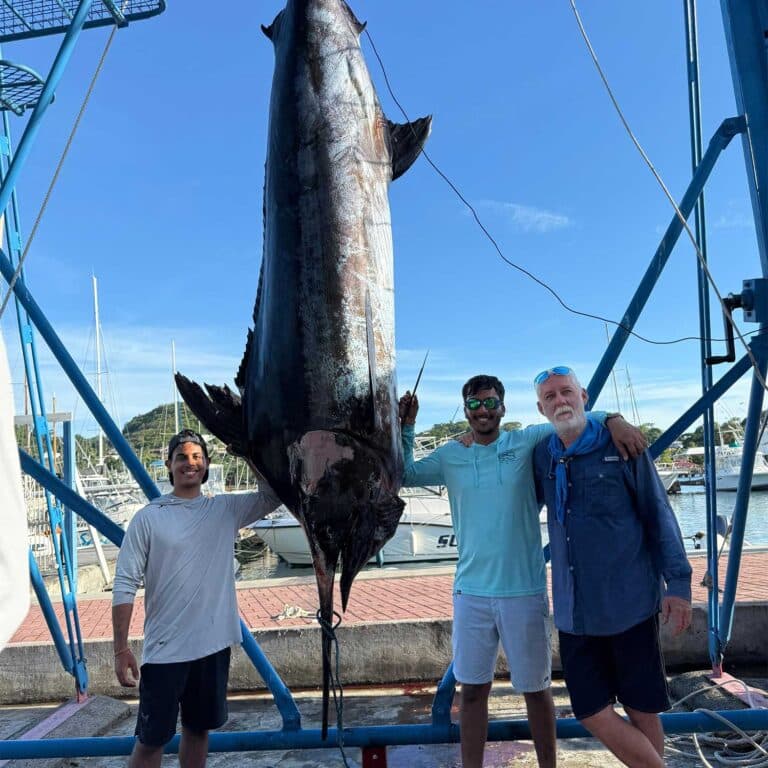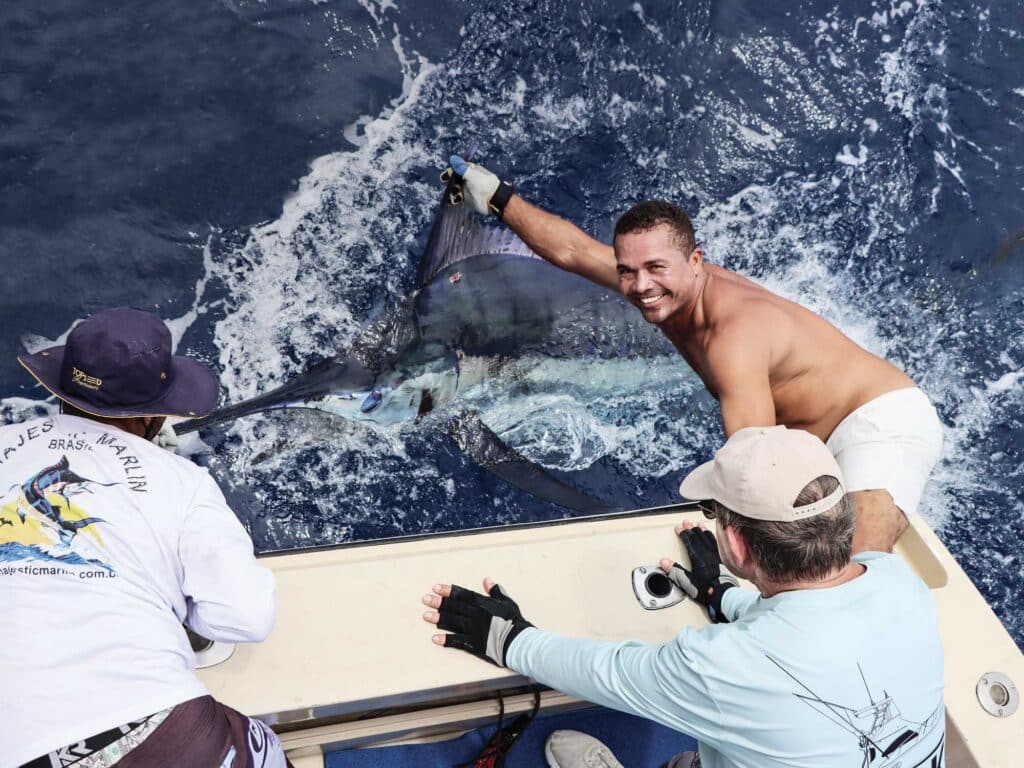
Special delivery: Sign up for the free Marlin email newsletter. Subscribe to Marlin magazine and get a year of highly collectible, keepsake editions – plus access to the digital edition and archives.
As our spread neared a floating wooden crate, the water suddenly lit up with flashes of electric blue and green. A school of 30-pound-class mahi-mahi darted beneath the surface, curiously inspecting our lures. Just as quickly as they appeared, they vanished, leaving us scanning the water in search of their next move.
And then it happened—a violent explosion of white water detonated on the right short lure. The reel’s drag screamed as a massive blue marlin broke the surface, tail-walking with breathtaking power.
After a grueling hourlong fight, the seasoned mate Reina grabbed the leader, and an estimated 850-pound blue came boatside. This all happened within the first two hours of fishing the Royal Charlotte Bank. Shawn Wallace, the captain I’d be fishing with for the next week, turned to me with a knowing grin and said, “Welcome to Brazil.”

Where Currents Collide and Blues Thrive
Throughout my travels to renowned sport-fishing destinations such as Cape Verde, Kona and the Great Barrier Reef, I’d often pose a simple question to the seasoned captains and mates: “If you could fish for big blues anywhere you haven’t been, where would it be?” Almost without exception, their answer was the same: Canavieiras, Brazil.
The allure of Canavieiras lies in its unparalleled access to the Royal Charlotte Bank, a vast underwater plateau stretching over 55 miles into the Atlantic Ocean. This unique formation is where the Brazil Current, uninterrupted for thousands of miles, slams into the bank’s steep shelf that rises dramatically from the depths of thousands of feet to just 100 feet below the surface. The result is an explosion of life, a marine oasis in what is otherwise a liquid desert of open ocean.
Fueled by this collision, nutrient-rich upwelling creates a thriving ecosystem, attracting baitfish in staggering numbers. These baitfish, in turn, draw apex predators such as yellowfin tuna, wahoo, mahi-mahi and, most notably, large blue marlin. It’s a chain reaction of abundance, with the Royal Charlotte Bank as the keystone supporting it all.
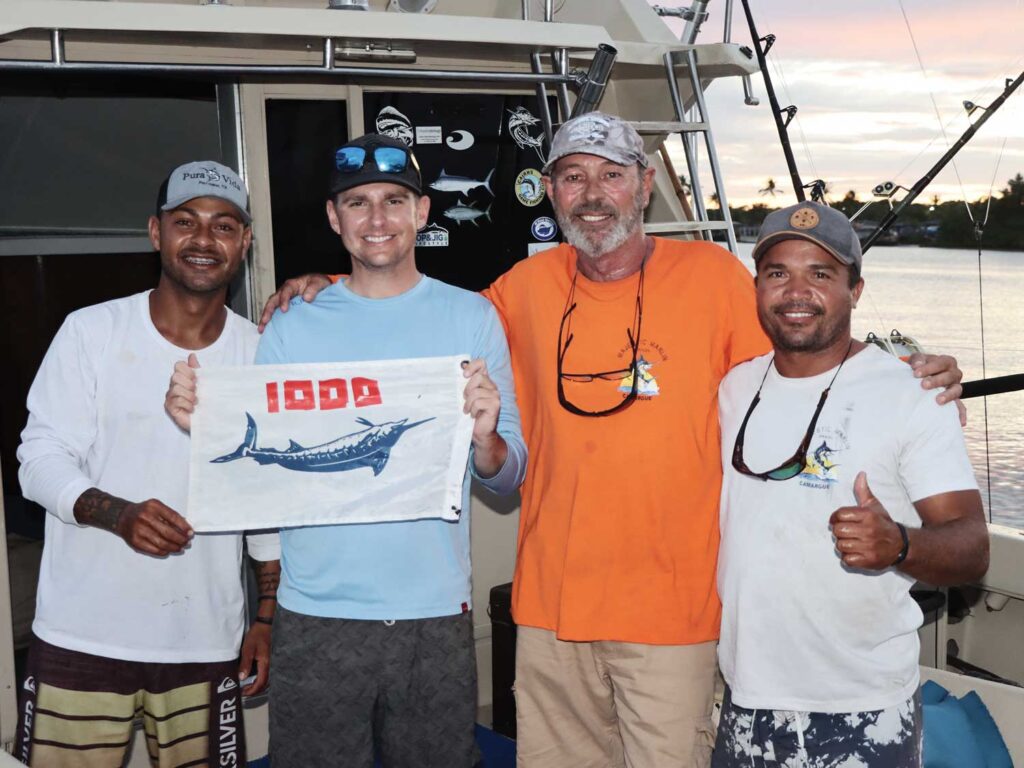
From the Reef to the Bank
Mark Twain once said, “The two most important days in your life are the day you are born and the day you find out why.” For Wallace, his why has never been in question—he has dedicated his life to traveling the world in pursuit of the largest marlin the oceans have to offer.
That passion was ignited by his father, Capt. Dennis Wallace, better known as Brazakka—an aboriginal term meaning “wild man.” His fishing career began at the age of just 15, working on Australian trawlers off the New South Wales coast. But in 1968, as Cairns started emerging as an epicenter of sport fishing, Brazakka made his move. He purchased George Bransford’s iconic Sea Baby, becoming only the third charter operator in the region’s fledgling gamefishing fleet.
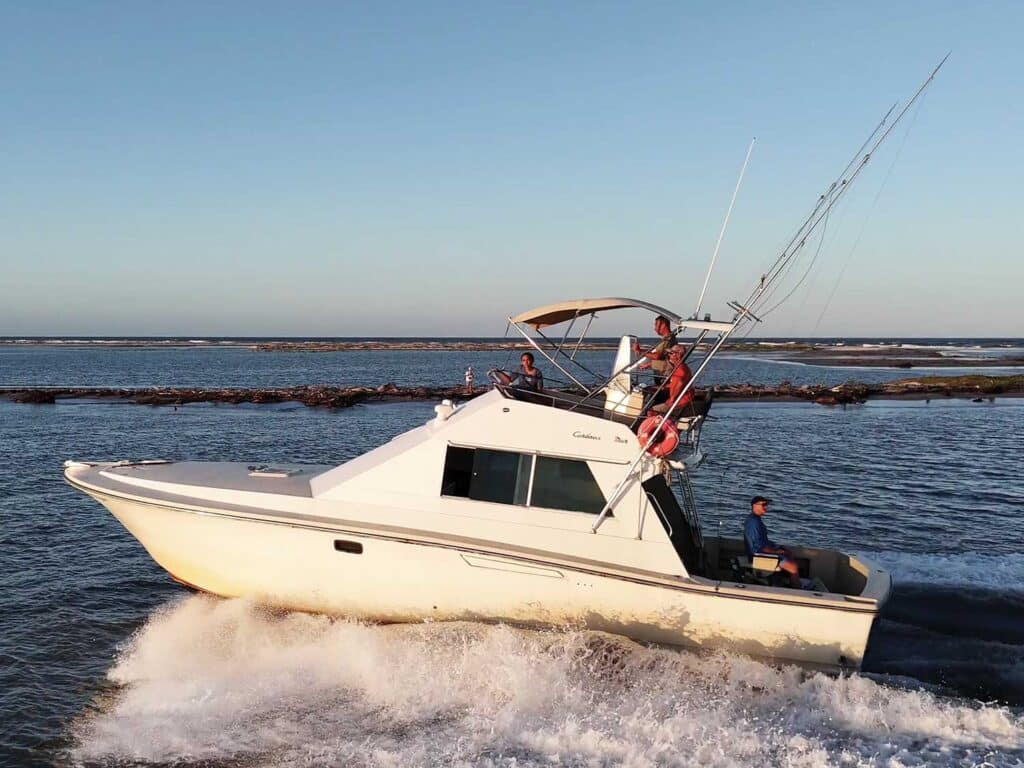
Brazakka didn’t just participate in the burgeoning fishery—he revolutionized it. He designed and captained the first self-contained, live-aboard gamefishing boat on the reef, a concept that has become the industry standard for today’s fleet. His reputation for colorful antics and quotable one-liners made him a legendary figure that earned him appearances in beer commercials; in the movie Brazakka’s Reef, starring Lee Marvin; fishing with President Jimmy Carter; and even in a feature on the Australian version of CBS’ 60 Minutes. By 1975, Brazakka had weighed 18 granders, cementing his legacy as one of the most accomplished captains of the Great Barrier Reef.
Growing up immersed in this environment, Shawn’s path was set early. He spent more than 15 years fishing the reef, and his career took him to some of the most renowned fishing destinations across the globe. His life, however, took an unexpected turn with a single phone call.
Tim Choate, a pioneer in billfish conservation and a trailblazer in discovering what was then remote and untouched fishing destinations in Costa Rica, Guatemala and the Galápagos, called Wallace with a proposition. “Tim called me out of the blue one day and was giddy with excitement,” Wallace recounts. “He thought Canavieiras, Brazil, might be the world’s next premier, undiscovered big blue-marlin destination, and invited me down to explore.” Choate’s excitement stemmed from studying charts and speaking with local commercial fishermen who regularly had catches of tuna and mahi stolen by massive blue marlin.
Intrigued and without hesitation, Wallace excitedly agreed and intrepidly made his way to the small town of Canavieiras. He arrived in 2002, and it was a decision that would not only shape the rest of his life but also introduce the world to one of the best blue-marlin fisheries on the planet.
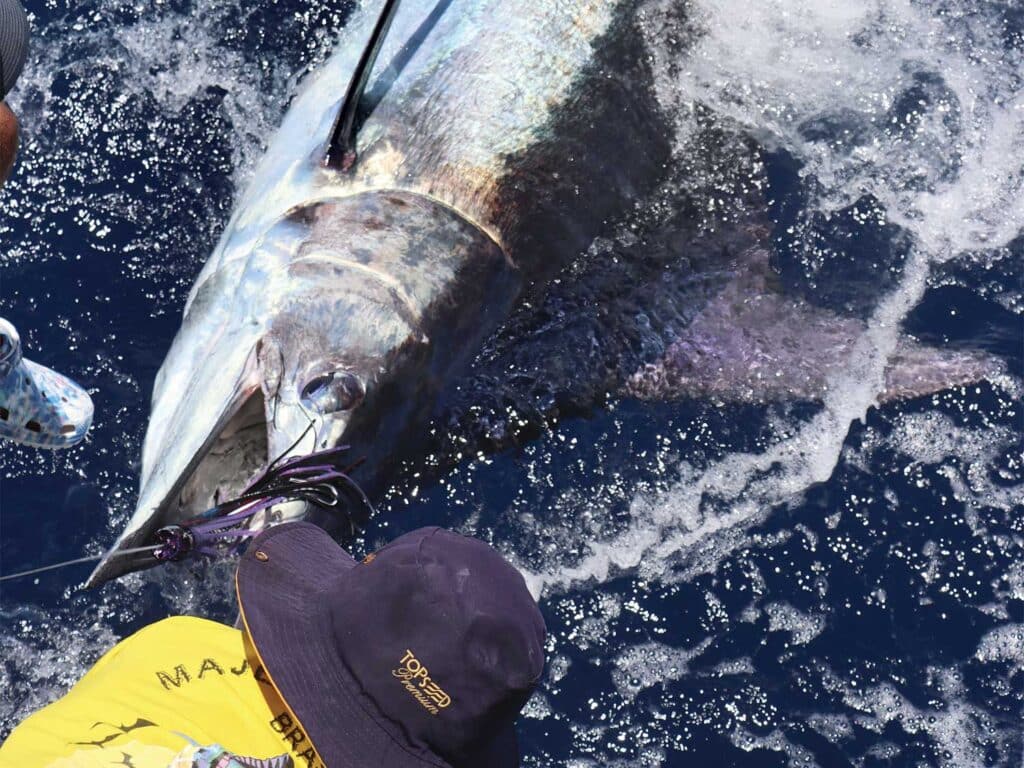
Heartbreak and Triumph
I stepped aboard Wallace’s boat, Camargue—a name inspired by the untamed, rugged horses of southern France and perhaps a fitting tribute to his father’s legendary “wild man” nickname—for the second day of fishing. The energy on deck was electric as we left the dock, anticipation running high after an unforgettable first day.
We eased down the sediment-laded Rio Pardo, the short stretch of river in Canavieiras that empties into the Atlantic. At the mouth, Wallace expertly navigated the ever-shifting channels of the bar before setting a course for the Royal Charlotte Bank. Fifteen miles out, we reached the beginning of the bank and set the spread.
Curious about the nuances of this fishery, I asked Wallace about his approach to fishing in such a sprawling area. “This bank is huge,” he explained. “The marlin are usually concentrated in specific sections, but it changes year to year, sometimes even week to week. And for reasons I can’t fully explain, certain spots always seem to produce bites while others don’t.”
The morning started “quietly” as we boated two large mahi-mahi and a wahoo. In the afternoon, the atmosphere shifted dramatically as we approached the middle of the bank, about 28 miles out. Bait erupted all around us—small yellowfin tuna, bigeyes and bonito busting on the surface.
As Wallace made an inside pass in only 300 feet of water, the shotgun rod went off. Unlike the first day, the marlin didn’t jump, and we were unsure of its size. After clearing the lines, we were deep into the braid and began backing down on the fish. It soon became apparent that this was another nice one as it started doggedly diving deep, and a tug-of-war ensued for the next 45 minutes. Just as the leader was within reach, the marlin rocketed out of the water behind the boat—a 700-plus-pounder. After the jump, the marlin swiftly changed directions, and the hook pulled.
The mood on board deflated. Seeing our disappointment, Wallace turned to me reassuringly. “Don’t worry, I have a feeling there’s going to be another one in here.”
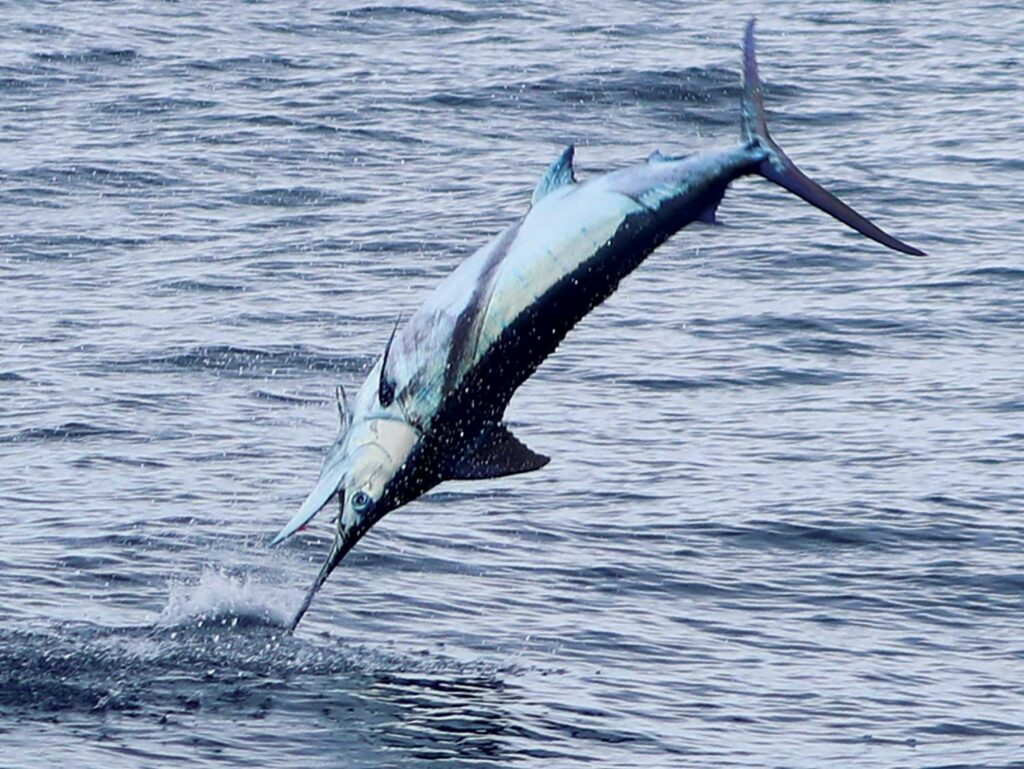
His instincts proved prophetic. We trolled a few miles up the bank before looping back to the spot of the original hookup. As we passed within 20 feet of the GPS mark of the first hookup, the right short exploded in a cascade of spray as a giant marlin came halfway out of the water, inhaling the lure.
This one was big—really big. Unlike the earlier fish, it stayed near the surface, allowing us to back down hard as it powered up-sea against the current. Water poured over the transom as we fought to keep pace. From the tower, Wallace called down, “Boys, this is a real one. The big girls often fight like this when they’re trying to pump more oxygen through their gills.”
The battle stretched over an hour, a tense back-and-forth struggle as we fought to gain line with the boat in reverse. Finally, Reina grabbed the leader and wrestled the marlin next to the boat. It wasn’t until then that we fully grasped its sheer size.
“It’s a giant!” exclaimed Wallace. Words escaped me as I stepped out of the chair and leaned over the side to get my first glimpse of the massive marlin. After snapping a few photos, the mates quickly removed the lure, and with a flick of its tail and a tidal wave of water, the marlin disappeared into the depths.
During my previous trips to the Great Barrier Reef, we weighed two marlin that unfortunately didn’t survive the fight—one at 963 pounds and the other at 978. This blue seemed just as big as, if not bigger than, those massive fish. While we’ll never know for certain, Wallace conservatively called it 950 pounds, knowing there was a good chance this fish crossed that magical thousand-pound mark.
As we celebrated on deck, Wallace turned to me with his signature grin and said, “I told you there’d be another one in there.”
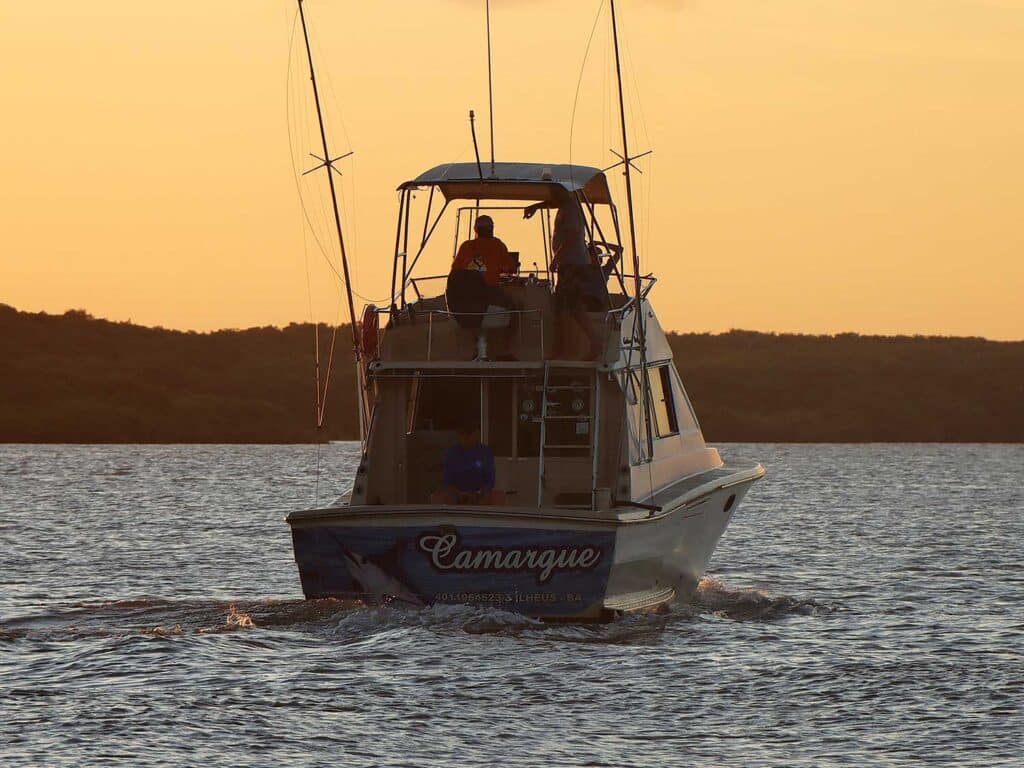
The Riddle of the Royal Charlotte Bank
Over seven unforgettable days, we landed nine blue marlin estimated at over 600 pounds and lost several others of similar size. Remarkably, we didn’t see a single fish under 500 pounds. While good numbers on the bank are common, this trip coincided with an extraordinary influx of large marlin. It made me wonder, “Why does the Royal Charlotte Bank consistently hold such big fish when in most places around the world, a fish of this caliber would be considered a once-in-a-lifetime catch?”
Was it the abundant food supply? A spawning location? The unique interplay of currents? Or perhaps something else entirely?
Seeking answers, I turned to Bruce Pohlot, the IGFA’s conservation director and co-leader of the International Great Marlin Race, a satellite tagging initiative designed to track marlin migrations across the world. After sharing my experience, I asked what was known about the migration patterns of Atlantic blue marlin.
“While our data is limited, we’ve observed some trends,” Pohlot explained. “Most tagged marlin off Bermuda travel east across the Atlantic to Africa; similarly, fish tagged in the Azores head east and south, often reaching Cape Verde or the African mainland. We’ve never observed marlin from these areas staying local or heading west.”
When I asked about the South Atlantic, he admitted, “We honestly don’t know much. Until last year, no blue marlin had been satellite-tagged south of the equator. Anthony Hsieh of Bad Company deployed a few tags on blue marlin over 500 pounds from the Royal Charlotte Bank, and we’re hopeful this will provide new insights when we get the data later this year.”
One thing became clear during our conversation: There are many more mysteries than answers to Atlantic blue-marlin behavior. Only through ongoing collaboration with recreational anglers can we continue to unravel these secrets and work toward protecting the species.
More Than Meets the Eye
When I arrived in Brazil, my mind was singularly fixated on marlin. The thrill of the strike, the grueling fight and the exhilaration of the release was all-consuming. But as the days passed, something began to change. Somewhere between the scream of a reel’s drag and the quiet moments watching the sunset on the way back from the bank, I realized marlin fishing isn’t just about catching fish but about the places it takes you.
The Royal Charlotte Bank is more than a fishing spot; it’s a destination that leaves an indelible mark. But somehow it still feels like a secret—a place that reveals its true magic only to those who embrace the journey as much as the catch.
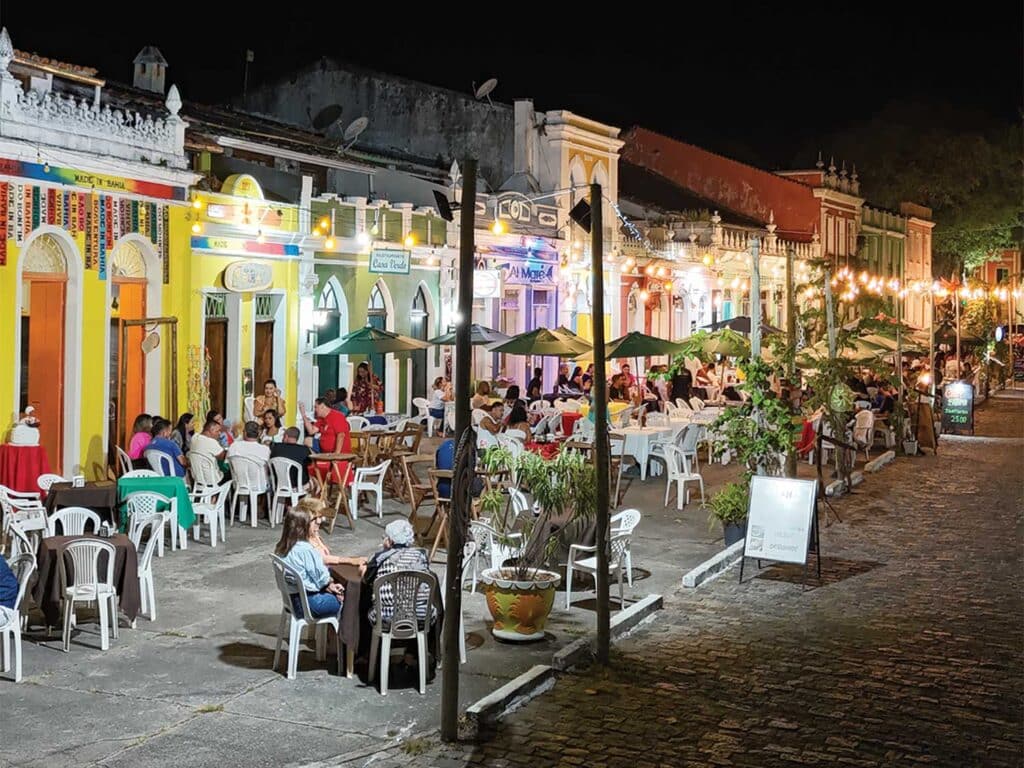
Traveling to Canavieiras
Getting to Canavieiras is simpler than it might seem. The journey can be broken down into three steps: 1) Fly into São Paulo or Rio de Janeiro; 2) hop on a two-hour connecting flight to Ilhéus; 3) Wallace will arrange a driver for the one-hour ride to Canavieiras.
For accommodations, Wallace offers a charming bed-and-breakfast, where most clients stay. It features a cozy common room, a large dining table and five private rooms, each with its own bathroom. The highlight, however, is the food: Breakfasts include eggs, fresh regional fruits, warm bread and local coffee, while dinners showcase Brazilian cuisine, often featuring the day’s catch—such as mahi-mahi or wahoo—prepared in a variety of ways.
Beyond fishing, Canavieiras boasts stunning beaches and is home to one of the world’s largest contiguous mangrove forests. Exploring the maze-like mangrove channels by skiff was an unforgettable adventure, revealing the area’s natural beauty from an entirely new perspective.
